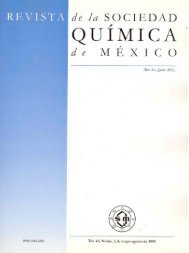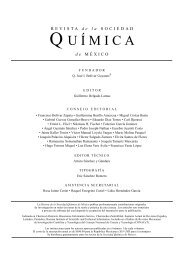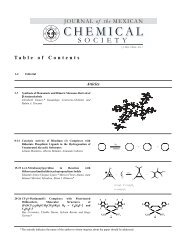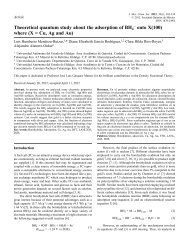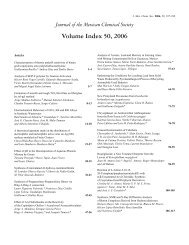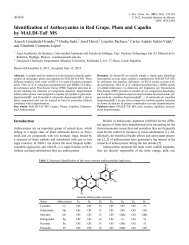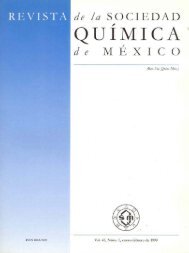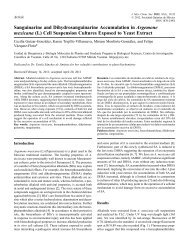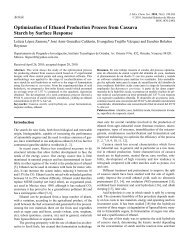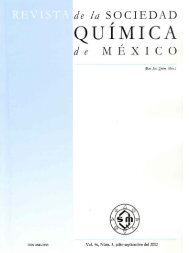SMQ-V047 N-002_ligas_size.pdf - Journal of the Mexican Chemical ...
SMQ-V047 N-002_ligas_size.pdf - Journal of the Mexican Chemical ...
SMQ-V047 N-002_ligas_size.pdf - Journal of the Mexican Chemical ...
Create successful ePaper yourself
Turn your PDF publications into a flip-book with our unique Google optimized e-Paper software.
Revista de la Sociedad Química de México, Vol. 47, Núm. 2 (2003) 186-189<br />
Investigación<br />
Cytotoxic Evaluation <strong>of</strong> a Series <strong>of</strong> Bisalkanoic Anilides<br />
and Bisbenzoyl Diamines<br />
Luis Chacón-García, M. Elena Rodríguez, and Roberto Martínez*<br />
Instituto de Química, Universidad Nacional Autónoma de México, Circuito Exterior, Ciudad Universitaria, Coyoacán 04510,<br />
México, D.F. E-mail: robmar@servidor.unam.mx<br />
Dedicated to Pr<strong>of</strong>esor Alfonso Romo de Vivar<br />
Recibido el 10 de marzo del 2003; aceptado el 26 de junio del 2003<br />
Abstract. A series <strong>of</strong> bisalkanoic anilides and bisbenzoyl diamines<br />
were syn<strong>the</strong><strong>size</strong>d with <strong>the</strong> aim <strong>of</strong> elucidating <strong>the</strong> relationship between<br />
molecular structure and cytotoxic activity. Twenty-one derivatives<br />
were syn<strong>the</strong><strong>size</strong>d and tested on three tumoral cell lines. No apparent<br />
relationship was observed between electronic effects and cytotoxic<br />
activity, but it was found that compounds in which <strong>the</strong> 4'-phenyl substituent<br />
is fluoride or bromide gave <strong>the</strong> best inhibition <strong>of</strong> tumoral cell<br />
growth.<br />
Keywords: Diamides, alkanediamides, cytotoxic activity.<br />
Resumen. El objetivo del presente trabajo fue encontrar la relación<br />
entre la estructura molecular y la actividad citotóxica de una serie de<br />
anilidas de diácidos y diamidas bisbenzoiladas, para lo cual se sintetizaron<br />
veintiuno de los compuestos mencionados. Los resultados de la<br />
evaluación citotóxica de estos derivados, en tres líneas celulares, no<br />
indicaron ninguna relación con respecto a efectos electrónicos de los<br />
substituyentes, si bien los derivados 4-brom<strong>of</strong>enil y 4-fluor<strong>of</strong>enil son<br />
los más activos.<br />
Palabras clave: Diamidas, alcano diamidas, actividad citotóxica.<br />
Introduction<br />
DNA recognizing molecules such as DNA-intercalators and<br />
groove binders have been <strong>the</strong> subject <strong>of</strong> increasing interest due<br />
to <strong>the</strong> ongoing search for more active antitumoral compounds.<br />
DNA-groove binders have been widely studied as anticancer<br />
compounds. In addition, <strong>the</strong>y have been studied as anti-HIV<br />
agents and have been incorporated as a linker in DNA bisintercalators<br />
[1-4]. The most typical DNA-groove binders are<br />
<strong>the</strong> antibiotics Distamycine A (1) and Netropsin (2), which are<br />
characterized by polyamide and polyaromatic functional<br />
groups along <strong>the</strong> DNA recognizing chain [5]. The aromatic<br />
portion <strong>of</strong> <strong>the</strong>se compounds is <strong>the</strong> pyrrolo system; however,<br />
recent studies have investigated compounds incorporating<br />
thiazolyl (3) or phenyl (4) (Fig. 1) instead <strong>of</strong> pyrrolyl, and<br />
groove binders that contain <strong>the</strong> benzimidazolyl moiety have<br />
been described in earlier reports [6-8]. Recently, we reported a<br />
series <strong>of</strong> N,N’-(diaminophenyl)alkanediamides 5 which differ<br />
in <strong>the</strong> length <strong>of</strong> <strong>the</strong> aliphatic portion. These compounds were<br />
shown to inhibit <strong>the</strong> growth <strong>of</strong> tumoral cell lines, indicating<br />
that this topographical factor has an important influence on<br />
DNA recognition [9]. However, <strong>the</strong> cytotoxic activity <strong>of</strong> <strong>the</strong><br />
N,N’-(diaminophenyl)alkanediamides was low. The present<br />
investigation was undertaken to study <strong>the</strong> influence <strong>of</strong> aryl<br />
substituents in <strong>the</strong>se compounds and to find compounds <strong>of</strong> this<br />
type with improved cytotoxic activity. To achieve this, we<br />
syn<strong>the</strong><strong>size</strong>d a series <strong>of</strong> bisalkanoic anilides and bisbenzoyl<br />
diammines (6-27) and <strong>the</strong>ir activities as cytotoxic agents were<br />
evaluated.<br />
Results and discussion<br />
The N,N’-diarylalkanediamides (6-20) (Fig. 2) were syn<strong>the</strong><strong>size</strong>d<br />
by condensation <strong>of</strong> <strong>the</strong> respective 4-substitued aniline (2<br />
equiv.) with succinyl, glutaryl or adipoyl chloride (1 equiv.) in<br />
acetone while being stirred and cooled in an iced bath. The<br />
products were precipitated, filtered, and washed with acetone.<br />
Yields varied from 65 to 96 %.<br />
Compounds 21-23 and 25-27 were obtained as described<br />
for 6-20 but from condensation <strong>of</strong> <strong>the</strong> respective benzoyl chloride<br />
and ethylenediamine, 1,2-propanediamine, or piperazine<br />
as shown in Figure 2. The compounds were obtained in yields<br />
<strong>of</strong> 75 to 95 %. Compound 24 was obtained by reduction <strong>of</strong> <strong>the</strong><br />
nitro derivative 23, using Pd/C and hydrazine in ethanol at<br />
reflux for 1 h. Recrystallization from methanol afforded <strong>the</strong><br />
amine derivative. The yields and spectroscopic data <strong>of</strong> compounds<br />
6-27 are summarized in Table 1.<br />
The percentage <strong>of</strong> inhibition <strong>of</strong> <strong>the</strong> growth <strong>of</strong> <strong>the</strong> three<br />
tumoral cell lines after treatment with each compound at a<br />
concentration <strong>of</strong> 31 µM is given in Table 1. The groups bonded<br />
at <strong>the</strong> 4’ position were selected on <strong>the</strong> basis <strong>of</strong> <strong>the</strong>ir electron<br />
withdrawing or donating properties, and <strong>the</strong>ir hydrogen<br />
bonding capabilities.<br />
The first series <strong>of</strong> compounds comprises N,N’-diarylalkanediamides<br />
with different numbers <strong>of</strong> methylenes in <strong>the</strong><br />
aliphatic chain. The first compounds syn<strong>the</strong><strong>size</strong>d and probed<br />
were 6 to 10 (n = 2). These compounds displayed little activity<br />
in <strong>the</strong> three cell lines. The compound which inhibits cell<br />
growth to <strong>the</strong> greatest extent (57 % in K562) is 6 (R = F), followed<br />
by 7 (R = Br) in <strong>the</strong> same cell line.




